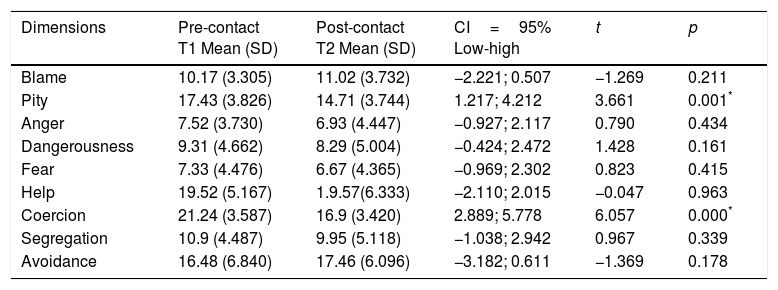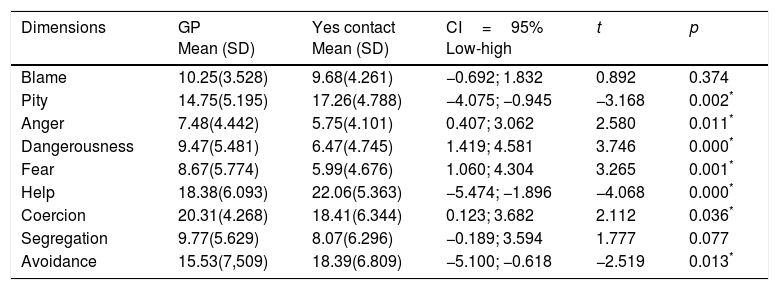The stigma associated with mental illness is a health problem, discriminating and limiting the opportunities for sufferers. Social contact with people suffering a mental disorder is a strategy used to produce changes in population stereotypes. The aim of the study was to examine differences in the level of stigma in samples with social contact and the general population.
MethodThe study included two experiments. The first (n=42) included players in an open football league who played in a team with players with schizophrenia. In the second included, a sample without known contact (n=62) and a sample with contact (n=100) were compared. The evaluation tool used was AQ-27, Spanish version (AQ-27-E). The mean difference between the two samples of each of the 9 subscales was analysed.
ResultsIn the first experiment, all the subscales had lower scores in post-contact than in pre-contact, except for responsibility. The two subscales that showed significant differences were duress (t=6.057, p=0.000) and Pity (t=3.661, p=0.001).
In the second experiment, seven subscales showed a significance level (p<0.05). Segregation and responsibility and did not.
ConclusionsIt is observed that the social contact made in daily situations can have a positive impact on the reduction of stigma. This can help to promote equality of opportunity.
El estigma asociado a la enfermedad mental es un problema de salud, discriminando y limitando las oportunidades de las personas que lo padecen. El contacto social con personas que sufren un trastorno mental es una estrategia utilizada para producir cambios en los estereotipos en la población. El objetivo del estudio fue examinar las diferencias en el nivel de estigma en muestras con contacto social y población general.
MetodologíaEl estudio incluye dos experiencias. La primera (n=42) incluye jugadores de una liga de fútbol abierta en la que juega un equipo de jugadores con diagnóstico de esquizofrenia. En la segunda se compara una muestra sin contacto conocido (n=62) y una muestra con contacto (n=100). La herramienta utilizada de evaluación fue el AQ-27, en versión española (AQ-27-E). Se analizaron la diferencia de medias entre las dos muestras, de cada una de las 9 subescalas.
ResultadosEn la primera experiencia, todas las subescalas presentaron menor puntuación en poscontacto que en precontacto, excepto responsabilidad, dos subescalas que mostraron diferencias significativas fueron coacción (t=6,057, p=0,000) y piedad (t=3,661, p=0,001).
En la segunda experiencia, siete subescalas mostraron nivel de significación (p=<0,05). Responsabilidad y segregación no lo mostraron.
ConclusionesSe observa que el contacto social realizado en entornos cotidianos puede producir un impacto positivo en la reducción del estigma, esto puede contribuir a favorecer la igualdad de oportunidades.








